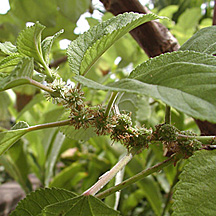
|
In the Garden
|
Growing mamaki will
help the Kamehameha
butterfly
Pipterus albidus
Description: Large shrubs or small trees 5 to 15 feet tall that generally have light green leaves with whitish undersides and either green, pink or reddish veins. The leaves range from about 4 inches to a foot across and are fairly rough to the touch. Flowers are insignificant in appearance but develop into fleshy white fruit, connected to the stem at the same point the leaf connects. A single plant can have hundreds of fruit at a time, and each fruit contains many tiny brown seeds from which new plants will develop.
![]()

Landscape use and care: Mamaki does well as an understory shrub or in semishaded areas. It also does fine in full sun with moderate watering. As with most plants, mamaki does better in well-drained soil. Few pests bother it, but spider mites might colonize under the leaves. Wiping them off with soapy water should take care of it (see below).
Cultural Uses: Mamaki was used to make kapa (clothing) when the softer, more preferred wauke (paper mulberry) wasn't available. Mamaki is commonly used to make a mild but invigorating and healthy tea.
More information: If caterpillars are present, be careful about spraying the plant. Those caterpillars could be the larvae of the native Kamehameha butterfly, which uses mamaki as a host plant. You also don't want to spray with pesticides if you plan on using the plant for tea. As for the butterfly, the adult looks similar to a non-native monarch butterfly, but with more bold designs and a fuzzier body. The Kamehameha butterfly is becoming increasingly rare because not as much mamaki is available for it to thrive on. On the other hand, more monarch butterflies are seen, as more people have been planting their favorite host plant -- the crown flower -- which is not native to Hawaii. By planting mamaki in your garden, not only will you be helping to increase the number plants, but also the number of Kamehameha butterflies.
nativehawaiianplants.com
![]()
E-mail to Features Desk
[News] [Business] [Features] [Sports] [Editorial] [Do It Electric!]
[Classified Ads] [Search] [Subscribe] [Info] [Letter to Editor]
[Feedback]
